Àngels Comella
Joan Yeguas, curator of the Museu Nacional d’Art de Catalunya’s Renaissance and Baroque Art collection, mentioned the historical and artistic interest of this magnificent polychrome woodcarving, dated to about 1689, in a previous post. I shall now refer to the restoration and conservation process to which it has been subjected, and which has enabled us to corroborate that it is not a Christ in Majesty but actually Saint Wilgefortis (Lliberada), the bearded female saint crucified on the cross, whose iconography is so unfamiliar, venerated for centuries.
As is very often the case, it was a request for the work to appear in an exhibition that led to it entering the laboratory of the Museu Nacional’s Department of Conservation, so that it could be examined, analysed and finally restored.
What state of conservation was the carving in?
Entered in 1879, it had never been exhibited to visitors due to its poor general state, with a lot of dirt stuck to it and numerous losses of polychromy.
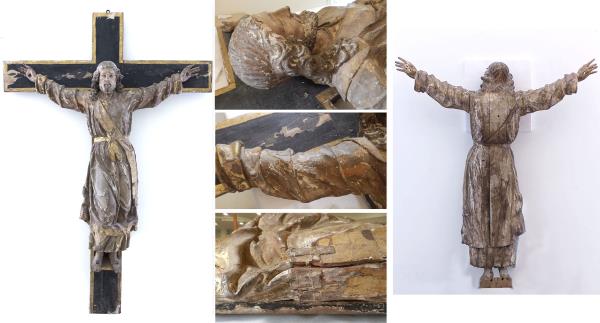
The carving, in solid polychrome wood, also had parts of the wooden support missing and there were a great many holes caused by a massive attack of xylophagous insects. A large part of the paint on the wooden support had peeled off, leaving gaps in the polychromy that were impossible to fill and numerous blisters on the paint layer that showed there was an imminent risk of further losses. In fact, as protection some areas had already been repaired provisionally with Japan paper and glue.
The paint layer appeared to be completely altered and darkened; the varnishes were oxidized and there was also a large accumulation of dirt on the surface. Moreover, the tunic appeared to be far more matt and porous than the flesh zones.
Even though there is no written record of any previous restoration work, the carving presented interventions on various fractures at shoulder height and on the hands. These fractures had been repaired and stuck back on using an epoxy resin applied rather crudely and, for reasons unknown, the process of restoration had not been completed.

After assessing its condition, our final diagnosis was that the the sculpture needed comprehensive conservation-restoration work done on it in order to stabilize it in order for it to be exhibited in the show Baroque Craftsmen: Cervera and the Art of its Time (Museu de Cervera, 2019/2020).
The process of repairing the carving
- First, an initial stage was essential to repair the polychromy on much of the surface, in order to prevent more losses due to any further handling.
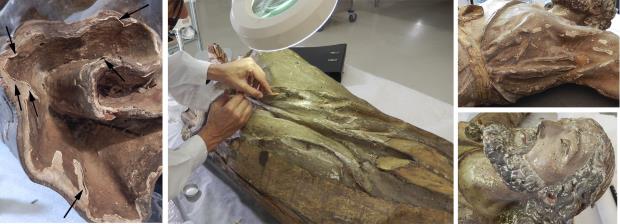
- The work was placed in the anoxia disinfestation chamber for disinsectization. Then an exhaustive photographic documentation was made of the whole work, and also with the figure separated from the cross.
- The process of repairing the paint layer, especially that of the tunic, was the longest, slowest and most difficult of all, as there were numerous peelings and blisters between the wooden support and the paint layer. At these points small holes had to be made with a needle to inject the glue into them. The repair work was done by applying animal glue diluted with deionized water, with the aid of a brush or a syringe and controlled heat.
- The surface cleaning stage was begun whenever possible before or at the same time as the repair stage. The accumulated dust was removed with the aid of a very soft brush and a micro vacuum cleaner.
In the chemical analyses of the micro-samples taken from the surface layer of the polychromy the presence was detected of aluminosilicates, oxalates, traces of protein, calcium carbonate and plaster. As for the technique, it was confirmed that the flesh tones, hair and beard were agglutinated in oil while the paint layer of the tunic was painted in tempera and was originally blue. It is a pigment, blue enamel, that is irreversibly altered with the passage of time, becoming discoloured, and the polychromy ends up acquiring a grey-ochre hue. I should mention that blue enamel began to be used in the late 16th century and fell out of use in the early 19th century. It is a potassium glass containing ground cobalt.
The analyses also indicated the presence of a second covering with polyvinyl acetate applied later, probably to fix the paint layer, a material that deteriorates over time.
The presence of these materials, on one hand intrinsic to making the work, and, on the other, products added later, would explain the rapid onset of the high degree of alteration, the irreversible colour change of the tunic, and the difficulties that we encountered during the process of cleaning the paint layer.

In a phase of more in-depth cleaning, different combinations of solvents were used according to the Cremonesi cleaning system. As we have said, the level of dirt stuck to the paint layer and of colour change was very high. During the process an attempt was made to cautiously eliminate the oxidized varnish and the layer of dirt and altered materials. Since, chiefly on the tunic, this was not always possible without the risk of damaging the original paint film, at these points cleaning was not insisted on.
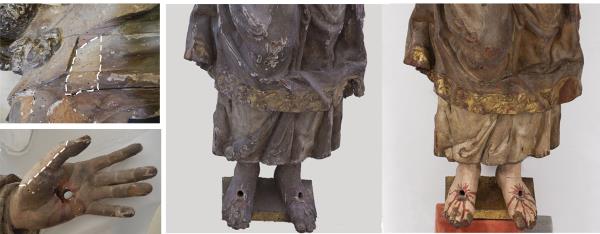
- Note: the sleeves and the edges of Saint Wilgefortis’ tunic are gilded with badly deteriorated gold leaf where the Armenian bole applied beneath breathes. During the process, moreover, some delicate decorations have been recovered on the gold with floral motifs in alternating green and matt red, which had become dull due to the dirt on the work as a whole. The technique used here is the one known as sgraffito (estofat).
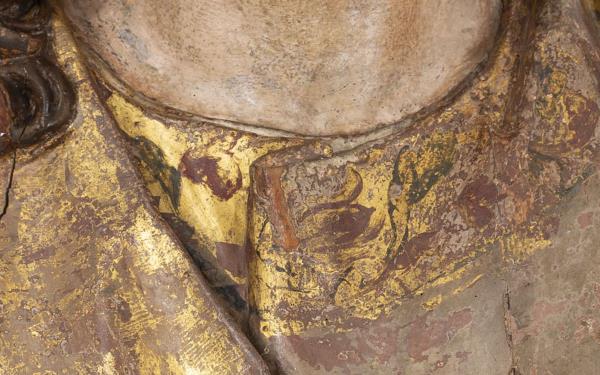
- On the back of the carving, above the feet, and stuck to the bottom of the white skirt, we found traces of beautiful bobbin lacework that originally decorated the entire hem. On the front of the skirt, the imprint can be seen left by this lacework, now lost, that enables us to deduce that it was probably the decoration of a woman’s gown, trimmed at the same time with an elegant hem and a striking golden bow.
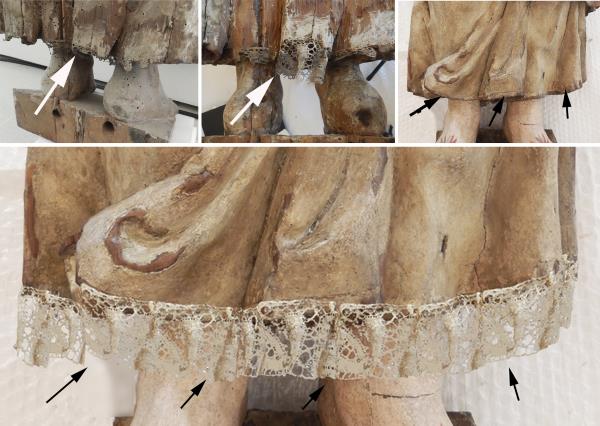
- Other elements confirm that the carving was of a woman. We were able to confirm that the artist carves, in the shape of the left breast, a prominent rounded volume much more typical of a woman than a man. We also see that the crucified saint describes a quite sinuous movement of the hip.
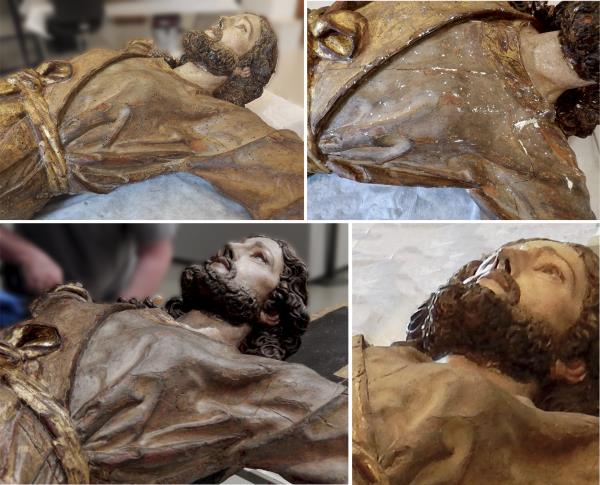
- When the cleaning stage was finished and with the carving now varnished, the stage of levelling with stucco began. It was agreed to cover only the woodworm holes and not to repair the many losses of polychromy, following criteria of minimal intervention.
- The paint repair was limited to homogenizing the colours of the polychromy.
- Finally, with pigments and retouching vanish based on transparencies the whitish areas of the original layer of preparation were dyed so that they would blend in with the work as a whole.
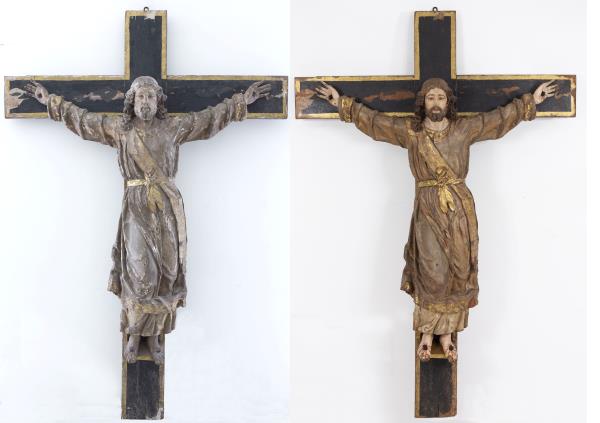
The conservation-restoration process of the image of Saint Wilgefortis has given us the chance to study and learn about the process of creating the work that has recovered part of its original splendour and which is now ready to be admired in the rooms of the Museu Nacional.
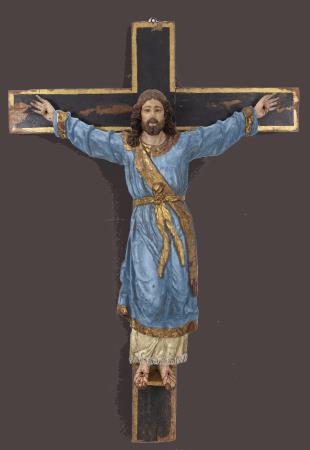
Related links
A bearded woman crucified: the Saint Wilgefortis of Andreu Sala
The periodic table through the rooms of the museum II
Conservació-restauració







